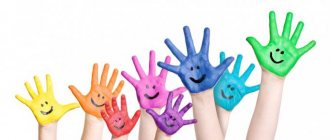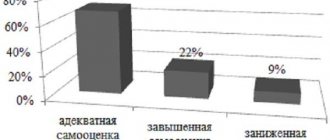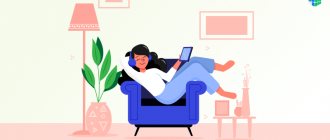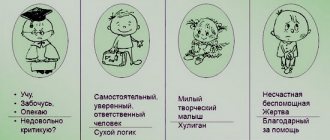The Lüscher test is a test developed by Swiss psychotherapist Max Lüscher to study personality. The essence of the test is to rank colored cards. Based on your individual preferences between colors, you can draw certain conclusions about your personality.
We invite you to take our online Self-Discovery program to get to know yourself better. In 4 weeks, with the help of psychological tests and exercises, you will find out what you really want in life and understand your strengths and weaknesses.
Content
- 1 Description of the technique
- 2 Purpose of the technique
- 3 Advantages of the technique
- 4 History of creation
- 5 Adaptations and modifications
- 6 Theoretical (methodological) foundations
- 7 Methodology structure
- 8 Procedure 8.1 Instructions (for psychologist)
- 9.1 Election markings
- 11.1 Cards
Advantages of the technique
Each of the eight colors of the test was carefully selected according to its special psychological and physiological meaning - its structure - for this purpose, preliminary experiments were carried out over the course of five years with 4500 shades of colors. Their meaning is universal, it remains the same for different countries, does not depend on age, the same for men and women, educated and uneducated, or “civilized” and “uncivilized.” Many people are prejudiced against “psychological tests” primarily if they have to answer countless, time-consuming questions or if they are forced to sort through a lot of cards. Experience with the Luscher test shows that the number of those who do not accept it is very small. The test is attractive, it can be completed quickly, and the test takers do not feel that they are compromising their dignity by choosing colors. They might change their minds if they knew how revealing the test really is.
History of creation
The first edition of the test, which brought the author worldwide fame, was published in 1948. In 1970, M. Luscher released a voluminous manual for his test. The theory and practice of the method are also presented in such books by Luscher as “Personality Signals”, “The Four-Color Man”, etc.
The test colors were selected experimentally by Luscher from 4,500 color tones. The author specifically emphasizes that adequate diagnostics from the standpoint of his method is only possible when using a standard, patent-protected set of color stimuli.
Test author
Max Luscher (M. Luscher) was born on September 9, 1923 in Switzerland in the city of Besel. He studied sociology, philosophy of law and religion, clinical psychiatry, and psychotherapeutic methods. In 1949, he successfully defended his dissertation on philosophy and psychology, “Color as a tool for psychodiagnostics.” Luscher's main activities are conducting training seminars for psychologists and psychotherapists, supporting scientific research in the field of color diagnostics, as well as lecturing in Eastern and Western Europe, the USA and Australia. He was an honorary member of the International Rorschach Society in Rome, president of the Luscher Diagnostic Center in Rome and the Max Luscher Institute in Padua.
Adaptations and Modifications
The color selection method proposed by L.N. Sobchik is an adapted version of the Luscher color test. The method is intended to study unconscious, deep-seated problems of personality, current state, basic needs, individual style of experience, type of response and degree of adaptation of the subject. In addition, it allows us to identify a person’s compensatory capabilities and assess the severity of painfully acute character traits and clinical manifestations.
Theoretical (methodological) foundations
The development of the Luscher test is based on a purely empirical approach and is initially associated with the aim of studying the emotional and physiological state of a person for the purpose of a differentiated psychotherapeutic approach and to assess the effectiveness of corrective action. The technique is devoid of any serious theoretical justification, hints of which appeared only in the later works of both Luscher himself and his followers. The interpretative approach of the methodology, which is very eclectic, is based on the socio-historical symbolism of flowers, elements of psychoanalysis and psychosomatics. The experience of using the Luscher eight-color test in domestic conditions not only confirmed its effectiveness, but also made it possible to comprehend its phenomenology in the context of the modern scientific worldview. Its advantage over many other personality tests is that it is devoid of cultural and ethnic basis and does not provoke (unlike most other, especially verbal tests) reactions of a defensive nature. The technique reveals not only the conscious, subjective attitude of the subject to color standards, but mainly his unconscious reactions, which allows us to consider the method as deep, projective.
Why was the Luscher test created?
The Luscher test is used to measure the psychophysiological state of a person, his resistance to stress, activity and communication skills. The author’s idea is based on the fact that the perception of color is not subjective, but universal, while color preferences, on the contrary, are subjective and are capable of diagnosing a person’s current state.
This test is very easy and quick to take, and at the same time is considered “in-depth”, created for specialists, psychiatrists, psychologists and doctors. Each color carries a certain energy charge, which causes both physiological and psychological effects in a person.
It is a projective technique and is based on the fact that the choice of color often reflects a person’s focus on a certain type of activity, on satisfying needs, and reflects his functional state.
Method structure
The Luscher test in the original is presented in two versions: a full study using 73 color tables and a short test using an eight-color series. The first of them is quite cumbersome and is most likely of value in cases where the color test is the only tool for psychodiagnostic research. At the same time, the final result of the research is not so extensive information compared to the time and effort spent. The brevity and ease of use of the eight-color range is a great advantage of the shortened version, especially since when applied to a battery of test methods, the reliability of the data obtained increases. Full version of the Luscher test
The full version of the CTL - “Clinical Color Test” consists of 7 color tables:
- "gray"
- "8 colors"
- "4 primary colors"
- "of blue color"
- "Green colour"
- "Red"
- "yellow color"
To table 1
“gray color” includes - medium gray (0; it is similar to gray from the 8-color table), dark gray (1), black (2; similar to 7 from the 8-color table), light gray (3) and white (4).
table 2
The full version is similar to the 8-color table of the short version of the Luscher test.
Table 3:
dark blue (I1), blue-green (D2), red-yellow (O3) and yellow-red (P4). Each color is presented in the table 3 times (as well as the colors of subsequent tables) for the purpose of pairwise comparison of colors by the subjects. The colors are similar to the 4 “primary” tones in Table 2.
Table 4:
dark blue (I1), green-blue (D2), blue-red (O3), light blue (P4). In this table, the dark blue color (I1) is similar to the dark blue in tables 2 and 3. The use of the same color (“main”) in several CTL tables allows, from Luscher’s point of view, to more deeply study the subject’s attitude towards it .
Table 5:
brown-green (I1), blue-green (D2), green (O3) and yellow-green (P4). Here, for the third time, blue-green (D2) is present.
Table 6:
brown (I1), red-brown (D2), red-yellow (O3), orange (P4). The first of these colors is similar to 6 from Table 2, and red-yellow (O3) appears the 3rd time.
Table 7:
light brown (I1), green-yellow (D2), orange with a greater proportion of red (O3) and yellow-red (P4). In the last CTL table, the yellow-red color (P4) is repeated for the third time.
CTL colors, starting in Table 4, refer to specific “color columns.” There are four of them - according to the number of “primary” colors. The “blue” column (I1) includes colors designated I1, the “green” (D2) column contains D2; “red” (O3) - O3; “yellow” (P4) - P4. Short version of the Luscher test
The short version is a table of eight colors:
- gray (conditional number - 0)
- dark blue (1)
- blue-green (2)
- red-yellow (3)
- yellow-red (4)
- red-blue or purple (5)
- brown (6)
- black (7)
Characteristics of colors according to Luscher
Luscher divided colors into 4 additional and 4 primary. Additional ones are brown (symbolizes stress), gray or zero (symbol of grief), purple (symbolizes anxiety) and black (symbol of worries).
The primary colors are blue, symbolizing calm and contentment, orange-red – symbolizing aggressiveness, willpower, excitement, blue-green, symbolizing stubbornness, confidence and perseverance, and light yellow – symbolizing activity and fun.
Procedure
The examination procedure proceeds as follows: the subject is asked to choose the most pleasant color from the tables laid out in front of him, without correlating it with the color of the clothes (does it suit the face), or with the upholstery of the furniture, or with anything else, but only in accordance with the fact that how much we prefer this color in comparison with others for a given choice and at the moment.
When laying out color standards in front of the subject, you should use an indifferent background. The lighting should be uniform and bright enough (it is better to conduct the study in daylight). The distance between color tables must be at least 2 cm. The selected standard is removed from the table or turned face down. In this case, the psychologist writes down the number of each selected color standard. The recording goes from left to right. The numbers assigned to the color standards are as follows: dark blue - 1, blue-green - 2, orange-red - 3, yellow - 4, purple - 5, brown - 6, black - 7, gray - 0.
Each time the subject should be asked to choose the most pleasant color from the remaining ones until all colors have been selected. After two to five minutes, having first mixed them in a different order, the color tables must be laid out again in front of the subject and the selection procedure must be completely repeated, saying that the study is not aimed at studying memory and that he is free to choose again the colors he likes the way he likes. it will be whatever.
Instructions (for a psychologist)
Shuffle the colored cards and place them with the colored surface facing up. Ask the subject to choose from eight colors the one he likes best. In this case, it must be explained that he must choose the color as such, without trying to correlate it with his favorite color in clothes, eye color, etc. The test subject must select the most pleasant Color out of eight. The card with the selected color should be set aside, turning the colored side down. Ask to choose the most pleasant one from the remaining seven colors. The selected card should be placed with the colored side down to the right of the first one. Repeat the procedure. Rewrite the card numbers in laid out order. After 2-3 minutes, place the cards again with the color side up and do the same. At the same time, explain that the subject should not remember the order of the layout in the first choice and consciously change the previous order. He should choose colors as if for the first time.
Instructions for passing the Luscher test
The testing procedure itself is very simple: the subject lays out cards with flowers in descending order of the degree of his personal, subjective liking for them. When taking the test, you should ignore any associations and generally accepted tastes, only your personal attitude.
It is believed that when testing you should use only original color cards, which, however, does not prevent you from taking it on a computer - the studies conducted did not show a significant difference in the results.
Processing the results
The first choice in the Luscher test characterizes the desired state, the second - the actual one. Depending on the purpose of the study, the results of the relevant testing can be interpreted.
As a result of testing, we get eight positions:
- the first and second are a clear preference (denoted by + +);
- third and fourth - preference (denoted x x);
- fifth and sixth - indifference to color (denoted = =);
- seventh and eighth - antipathy to color (indicated - -)
Based on an analysis of more than 36,000 research results, M. Luscher gave an approximate description of the selected positions:
- 1st position - the color you like the most, indicates the main method of action, i.e. a means to achieve the goals facing the subject.
- 2nd position - usually the color in this position is also indicated by a “+” sign, and in this case it means the goal that the subject is striving for.
- 3rd and 4th positions - usually the colors in these positions are indicated by the sign "x" and indicate the true state of affairs, situation or course of action arising from this situation (for example, the blue color in this case will mean - the subject feels that he is in a calm environment or that the situation demands that he act calmly).
- 5th and 6th positions - colors located in these positions and indicated by the “=” sign indicate specific features that do not cause hostility, are not associated with the existing state of affairs, currently unused reserves, personality traits.
- 7th and 8th positions - the color in these positions, marked with a “-” sign, means the existence of a suppressed need or a need that should be suppressed because its implementation would lead to unfavorable results.
Election markings
When reselecting colors, if two or more colors change position, but still remain near the color that was their neighbor in the first choice, then the group exists, and it is this group of colors that should be circled and marked with the sign corresponding to the function. Very often these groups differ somewhat from simple grouping into pairs.
Example:
1st choice - 31542607
2nd choice - 35142670
Grouping is done as follows:
| 3 | 1 | 5 | 4 | 2 | 6 | 0 | 7 |
| 3 | (5 1) | (4 2 6) | (7 0) | ||||
| + | X | X | = | = | = | — | — |
When making notes in the protocol of such a test, you should be guided by the following rules:
- The first group (or one digit) is marked “+”.
- The second group (or one digit) is marked with an "x".
- The last group (or one digit) is marked “-”.
- All other colors are marked with a “=” sign.
Where there are pairs of colors, interpretation should be made using these rather than individual colours.
Sometimes the same colors will have different symbols on the 1st and 2nd choices. In this case, each choice should be marked separately:
| + | + | X | = | = | — | — | — |
| 5 | 1 | 3 | 4 | 2 | 6 | 0 | 7 |
| 3 | 5 | 1 | 4 | 2 | 7 | 6 | 0 |
| + | X | X | = | = | = | — | — |
Usually the second choice is more spontaneous and therefore more valid than the first, especially in cases of doubt. In this regard, when using tables, you should first take into account the grouping and notes made during the second choice.
It may turn out that some numbers are common to two functional groups and then both groups should be interpreted with the corresponding notes in the protocol:
| + | + | — | — | |||||
| + | X | X | = | = | = | = | — | |
| 5 | 1 | 3 | 4 | 0 | 6 | 2 | 7 | 1st choice |
| 3 | 1 | 5 | 4 | 0 | 7 | 2 | 6 | 2nd choice |
| + | + | X | = | = | = | = | — |
In this case, you need to look at the following groups in the tables: +3+1, x1×5, =4=0, -2-6 (there are also additional groups: +3-6 and +3-2).
Adaptation study using the Luscher method
Determining a child’s emotional attitude towards school situations
The psychologist lays out colored cards in front of the child on a blank sheet of A4 paper in random order.
Instructions
1. Look carefully and tell me which of these colors most resembles your mood when you go to school in the morning? Most often, usually. Name it or point it with your finger.
2. What about at home on weekends?
3. Which of these colors most resembles your mood when you are sitting in class?
4. And when do you answer at the board?
5. And before the test or test?
6. When do you play or communicate with the guys during recess?
7. When do you talk to the teacher?
Now choose from these colors the one that you like best, which seems more beautiful than the others (the psychologist removes the card chosen by the child). And of the rest? (remove the card chosen by the child again, etc.).
When choosing blue, green, red, yellow colors, a positive attitude, attitude, emotional state, and good mood are noted.
When choosing black, a negative attitude, negativism, a sharp rejection of what is happening, and a predominance of bad mood are noted.
When choosing a gray color, a neutral attitude, lack of emotions, passive rejection, indifference, emptiness, and a feeling of uselessness are noted.
When choosing a brown color, anxiety, restlessness, tension, fear, and unpleasant physiological sensations are noted (stomach ache, headache, nausea, etc.).
When choosing the color purple, infantilism, whims, instability of attitudes, irresponsibility, and maintaining the “child’s position” are noted.
Determining a child’s emotional self-esteem
If the child’s general color choice begins with blue, green, red, yellow, then in this case the child’s self-esteem is positive, he identifies himself with good children.
If the general color choice starts with black, gray, brown, then in this case the child has a negative self-esteem, he identifies himself with bad people, and does not like himself.
If the general color choice begins with purple, then in this case the child has infantile self-esteem, personal immaturity, and maintains attitudes and behavior patterns characteristic of a younger age.
Interpretation of results (see table)
Table
Determining the emotional state of a child at school
| Color | Red | Yellow | Green | Violet | Blue | Brown | Black | Grey |
| Color location is ok | 1 | 2 | 3 | 4 | 5 | 6 | 7 | 8 |
| The place of color in a child's choice | 3 | 8 | 2 | 1 | 5 | 7 | 4 | 6 |
| Difference | 2 | 6 | 1 | 3 | 0 | 1 | 3 | 2 |
ES = 2 + 6 + 1 + 3 + 0 + 1 + 3 + 2 = 18
20 < ES < 32 - predominance of negative emotions. The child is dominated by a bad mood and unpleasant experiences. A bad mood indicates a violation of the adaptation process, the presence of problems that the child cannot overcome on his own. The predominance of a bad mood can disrupt the learning process itself, but indicates that the child needs psychological help.
10 < ES < 18 - normal emotional state. The child can be happy or sad, there is no reason for concern, adaptation proceeds generally normally.
0 < ES < 8 - predominance of positive emotions. The child is cheerful, happy, optimistic, and in a state of euphoria.
Analysis
If a child chooses brown, gray colors in all seven cases and purple in situations “well-being at home, general attitude towards school, relationship with the class teacher” - 0 points are given.
If you choose black color - 1 point.
When choosing blue, green, red, yellow - 1 point.
If the child’s answers are rated 6–7 points, the child’s overall emotional attitude towards school is positive.
If the answers are scored 4–5 points, a negative attitude may be expressed both towards the school as a whole and towards individual aspects of the educational process.
If the answers are scored 0–3 points, the child has a predominantly negative attitude towards school.
The emotional state of the child at school is analyzed separately.
Study of school anxiety
Instructions.
Now you will come up with stories based on pictures.
My pictures are not quite ordinary. Look, everyone - both adults and children - are drawn without faces. (Picture No. 1 is presented.)
This was done on purpose to make it more interesting to invent. I will show you pictures, there are 12 of them in total, and you have to figure out what mood the boy (girl) in the picture is in and why he is in that mood. You know that our mood is reflected on our face. When we are in a good mood, our face is cheerful, joyful, happy, and when we are in a bad mood, our face is sad, sad. I will show you a picture, and you will tell me what kind of face the boy (girl) has - happy, sad, or something else, and explain why he has such a face.
This technique ( see Appendix 4
) is of great importance in the study of student adaptation. By conducting a qualitative analysis of children’s responses, one can detect not only school anxiety, but also different indicators of school maladjustment. Indicators of maladaptation can be: a general negative attitude towards school; the child’s reluctance to study and attend school; problematic, conflictual relationships with classmates and the teacher; an attitude toward getting bad grades, condemnation from parents, fear of punishment, etc. Thus, the methodology for studying school anxiety can also be used to study the child’s general adaptation to school.
The authors of this technique suggest not interpreting picture No. 1, since it is a training picture, and No. 12, which is intended for the child to complete the task with a positive answer. In our study, we took into account children's responses to all pictures. First of all, because the first picture represents some diagnosis of intra-family relationships. Secondly, because student responses to picture No. 12 were not always positive. Moreover, many children misunderstood the meaning of this picture and interpreted it in their own way; therefore, the children’s answers were completely different.
We also believe that it is impossible to determine the level of school anxiety by the number of negative responses of a child, because these responses do not always indicate anxiety. For example, picture No. 8 (the child is doing his homework). In our opinion, answers such as “he is sad because the TV is broken”, “he is sad because he is alone and bored” are not indicators of school anxiety. We classify them as neutral answers that do not provide any data on the presence or absence of school anxiety in the child. But such answers make it possible to obtain additional information about the child, about his hobbies, desires, needs, interests.
However, it also happens the other way around: positive answers “he is cheerful because he sits at home, and the rest of the children go to school”, “he is cheerful because the lesson is over and he can play at recess”, “he is cheerful because he has not been given homework” also should not be considered as a lack of school anxiety in a child. Rather, on the contrary, the topic of school causes anxiety in the child and, perhaps, he tries in every possible way to avoid it. In addition, such responses are indicators of a child’s adaptation disorder. If he doesn’t want to study, it’s hard for him, he wants to relax and play, it means that he is not ready for school and gradually emerging learning difficulties can subsequently cause school anxiety and maladjustment.
Picture No. 1.
This picture can be used to analyze the relationship between parents and children: how close this relationship is; what unites this family; whether parents show love and care towards their child, or do not pay any attention to him. Many children give a positive interpretation to this picture: “the boy is happy because he is going for a walk with his mom and dad,” “the girl is in a cheerful mood because mom and dad are going to buy her a birthday present,” “they are in a good mood, dad and the mother goes to work, and the girl goes to school.” Such answers are scored 1 point. School anxiety can be observed in the answers: “he is in a sad mood, he doesn’t want to go to school,” “mom and dad are forcing him to go to school, he doesn’t want to.” Such answers are scored 0 points.
Picture No. 2.
This picture is an interpretation of the child’s educational motivation: whether he wants to go to school or not. Answers indicating high motivation, a desire to learn, to go to school: “she’s in a cheerful mood, she’s going to school, she wants to study,” “she’s happy to go to school,” “she likes going to school,” “she’s in a bad mood, she’s sick and cannot go to school” are scored 1 point. The answers of children in which school anxiety occurs are rated at 0 points: “he is sad, he doesn’t want to go to school,” “he doesn’t want to go to school, it’s not interesting,” “I’m leaving school, I don’t want to study.” These answers are not only indicators of anxiety, but also clear signs of school maladjustment. A number of neutral answers also stand out: “she’s in a bad mood, her mother calls him home, but he wants to go for a walk,” “someone offended her, they don’t want to be friends with her,” “she’s in a good mood, she’s talking to her mom,” “looks up and counts.” " These answers are scored as follows: if the answer is positive, 1 point is given, if the answer is negative, 0 points.
Picture No. 3.
This picture diagnoses the relationship between children - whether the child knows how to communicate and establish contact with classmates. Since the picture shows children playing, almost all the students’ answers were positive: “he’s playing, he’s having fun,” “he’s running,” “he’s scoring a goal” - 1 point. Negative answers such as “he is sad, he couldn’t catch the ball” are not indicators of anxiety. In this case, 0 points are given for the answers: “she is sad because no one wants to play with her or be friends with her,” “the boy stands aside, he is afraid to approach the guys,” “she is having fun, she doesn’t want to study, but wants everything.” day to play”, “I’m in a sad mood, three against one is impossible.”
Picture No. 4.
The woman depicted in this picture most often appears to children as a mother, and not as a teacher. Therefore, the positive answers were: “walks with mom,” “mom praises him,” “mom reaches out to hug her” — 1 point. Negative answers were divided into two groups. The first group includes answers in which school anxiety is observed: “Mom scolds me for doing my homework wrong,” “I didn’t study well, my mom scolds me,” “Mom scolds me for not getting an A,” “Mom scolds me for not getting to school.” went, doesn’t want to”, “she doesn’t want to go to school” are scored 0 points. The second group - neutral answers: “mom scolds, she has gone far from home”, “mom scolds for spilling water”, “mom scolds for dropping a flower”, “aunt scolds at him”, they are assessed as positive .
Picture No. 5.
The image in this picture is not always perceived by children as a learning situation. Just like in the previous picture, some students associate the teacher with their mother. Therefore, answers that are not related to the teacher and the learning situation can be considered neutral and scored 1 point. These are the following answers: “mom says “let’s go home,” but he doesn’t want to,” “they came to visit her, she is happy,” “mom asks to do something,” “mom gives money to go to the store.” However, school anxiety could be detected in some of the children's responses. “The teacher asks: “Where is your briefcase?” - and scolds him”, “the teacher scolds her, she didn’t study well”, “he’s in a cheerful mood, she’s playing around”, “he’s in a good mood, the teacher doesn’t scold him”, “he feels good, he’s the first, and the last boy can freak out” , “he was offended by the teacher, he scolds him.” Such answers are scored 0 points. Answers that are worth 1 point: “the teacher calls the children to her,” “she is having fun, she is talking to the teacher,” “they are studying,” “they want to study well.”
Picture No. 6.
This picture depicts a specific learning situation, so the children had no problems understanding its meaning. Using this image, you can identify the manifestation of school anxiety in a classroom situation. Positive answers that are scored 1 point: “they want to study well,” “he reads a lot,” “he sits well at his desk,” “he is at school, he learns everything,” “she sits in class.” Negative answers in which there is a child’s reluctance to study, a bad mood, fear, are scored 0 points: “she is studying, it’s difficult for her,” “she is in a bad mood, she wrote the wrong thing,” “she is in a bad mood, holds her hands incorrectly at her desk.” , “doesn’t know what to write,” “doesn’t want to study,” “bad mood, tired.”
Picture No. 7.
The picture shows a teacher, several children standing at her desk, and one child standing to the side, in the corner of the room. Most children with low adaptation talk about this particular child and give appropriate answers: “he’s standing in the corner, the teacher punished him, he did something,” “she’s standing in the corner, she tore the teacher’s papers,” “the teacher put him in the corner.” because he wrote it incorrectly”, “everyone is reading, but he stands in the corner, calling him names”, “they put him in the corner because he didn’t listen.” Such responses are a sign of possible maladjustment and behavioral disturbances in the child. They are scored 0 points, just like the answers of children with school anxiety: “she’s in a bad mood, she doesn’t want to hand over the work because she wrote it poorly,” “she’s afraid she might get a bad grade,” “one girl was given a book, but she doesn’t.” The children’s positive answers look like this: “he is talking to the teacher”, “the teacher praised him”, “they are given grades”, “the teacher checks the lessons and praises”, “she received a “5” - 1 point. The remaining answers not related to educational activities are considered neutral and are assessed by sign.
Picture No. 8.
In this case, it is easy to recognize answers containing school anxiety and low motivation to study: “she doesn’t want to study”, “his mother forces him to do his homework”, “she is sad, she can get a “2””, “she could not do her homework” . For such an answer 0 points are given. Children with no anxiety gave the following answers: “he writes, he likes it,” “she did her homework with an A,” “he sits and studies,” “he is in a good mood, he reads,” “he studies at home,” “his mood good, she’s doing her homework” – 1 point. Some children gave answers that were not related to educational activities; they cannot be used to judge the presence of anxiety and the child’s adaptation at school: “she’s drawing at home,” “she’s in a cheerful mood because it’s a day off,” “she’s watching TV,” “she’s sad, she’s at home.” alone,” “watching cartoons,” “he’s alone and bored,” “he’s sad, the TV isn’t working.” These responses are neutral and are also scored by sign.
Picture No. 9.
Here, it is also of great importance which child (standing aside or talking) the student begins to talk about. This picture helps to identify the child’s problems in relationships with classmates, the fear of quarreling, arguing, fighting with the guys, the fear that no one will be friends with him, play or talk. Children with similar fears gave the following answers: “nobody talks to him, he’s a poor student,” “they swear, fight, someone took the ball,” “they don’t play with her,” “they didn’t give her chocolate, they didn’t share it with her.” , “her classmates turned their backs on her,” “the girls kicked her out of the game,” “he was offended,” “no one plays with him or is friends with him.” These answers are scored 0 points, since fear is the first sign of anxiety, and if a child is afraid that they will not be friends with him, it means that he is not confident in himself and that he can find a common language with his classmates. And this is already one of the main indicators of maladjustment. The remaining answers: “they talk,” “she plays with girls,” “he meets boys,” “he plays with a boy” are scored 1 point.
Picture No. 10.
Analysis of children's responses to this picture, first of all, allows us to identify the relationship between the child and the teacher, and secondly, anxiety in the situation of answering at the blackboard. Students with a high level of anxiety gave the following answers: “he has a sad face, he doesn’t know the answer”, “the teacher asks him to draw, but he doesn’t know what”, “the teacher scolds him for playing around in class”, “he he has a sad face, he is afraid that the assignment will not work out,” “the teacher scolds her for not doing her homework,” “the teacher tells her to do her homework, but he doesn’t do it,” “the teacher forces her to write, but she doesn’t want to,” "The teacher scolds." They are scored 0 points. Answers worth 1 point were given by children who have a favorable relationship with the teacher and a high level of motivation to learn: “the teacher tells her something good,” “he went to the board to solve a problem,” “she answers a question,” “she is an excellent student.” “,” she is in a good mood, she was called to the blackboard,” “the teacher is teaching him,” “he is interested in answering,” “she was praised for her lessons,” “he wants to write on the blackboard.”
Picture No. 11.
This picture cannot reveal the presence of school anxiety in a child. But since a first-grader is a former preschooler, the attitude towards play activities is of great importance for the study. In the game, the child projects his life situations, which can be divided into situations of success and failure. In fact, the children's answers were divided. Positive answers, worth 1 point, reflect a situation of success: “they bought him a game”, “he is building”, “guests will come to her and play with her”, “she sits at home and plays”, “she has no lessons.”
And negative ones - a situation of failure: “he throws toys around, doesn’t help his mother”, “doesn’t want to study”, “he’s in a bad mood, he needs to collect toys”, “she’s sad, she couldn’t make a game”, “he scattered toys”, “she broke toys". Such answers are scored 0 points.
Picture No. 12.
The image in this picture is understood differently by children. From a variety of answers, we selected those that help identify school anxiety or, conversely, confirm its absence. Answers from children who show anxiety: “she’s in a sad mood, she’s been given a lot of homework,” “she just came, she has to do her homework, but she doesn’t want to,” “he’s not happy, he threw his briefcase and went to class,” “she’s sad, she was late for class,” “she barely came to school,” “he’s sad, he forgot his briefcase,” “angry, doesn’t want to study.” They are scored 0 points.
Positive answers regarding school are scored 1 point: “he goes home to do his homework, he likes to do his homework, and then he can relax, play with someone,” “he’s glad he’s going home,” “he gets dressed for school so that study quickly,” “goes home with a briefcase, she will do her homework and then go for a walk,” “goes home to do her homework.” We also identified a group of neutral answers: “she put on the wrong coat,” “the briefcase is heavy,” “she can’t lift her backpack, she’s tired,” “she’s going for a walk with her briefcase,” “she’s dancing,” “I found my mother’s bag,” “I bought myself a jacket.” ", "trying on clothes."
Analysis
Quantitative
. 10–12 points - we can say that the child has no school anxiety.
7–9 points—the level of school anxiety is normal.
0–6 points—presence of school anxiety.
Qualitative.
By carrying out a qualitative analysis of a single picture, it is possible to identify situations when a child is experiencing difficulties.
Picture No. 1 - communication with parents. The child’s relationship with his parents, his desire to communicate, and spend time together are analyzed.
Picture No. 2 - the road to school. The child’s desire to go to school, desire or unwillingness to learn is revealed.
Picture No. 3 - interaction with children. The child's attitude towards play activities. Problems in communication and interaction with a group of children are identified.
Picture No. 4 - communication with an adult (teacher). Using this picture, you can determine whether a child knows how to communicate with an adult, as well as obey his demands. Problems are discovered in the relationship between child and teacher, child and mother.
Picture No. 5 - communication with an adult (teacher). The situation is similar to the previous one. Does the child know how to interact in a group of children and obey the rules and requirements of an adult?
Picture No. 6 - lesson situation. You can determine the child’s mood in the lesson, his desire to learn, to complete the tasks proposed by the teacher; in addition, learning problems can be identified. You need to pay attention to whom the child chooses: the boy at the first desk with notes in a notebook or the boy at the second desk whose notebook is empty.
Picture No. 7 - lesson situation. This picture allows you to determine the relationship with the teacher and with the children. In addition, you can understand how the child evaluates his knowledge and himself. For example, a child says: “He is happy because he got a “5” or “He is sad because he got a “2.” The picture also makes it possible to identify violations in behavior. For example, a child says: “They put him in a corner, he was playing around.”
Picture No. 8 - the situation at home. Using the picture, you can determine the child’s mood and well-being at home and assess the desire to do homework.
Picture No. 9 - interaction with children. The situation of personal communication between a child and children. Identifies problems in communication, establishing friendly contacts, and the child’s attitude towards a quarrel.
Picture No. 10 - the answer is on the board. Allows you to identify the child’s fear of answering in front of the whole class, completing assignments on the board, and helps assess problems in the relationship between the child and the teacher.
Picture No. 11 - the situation at home. This picture does not reveal school anxiety, but it helps to clarify the child’s attitude towards single-player play.
Picture No. 12 - returning from school. You can understand the child’s general attitude towards school, as well as his desire or reluctance to leave school.
Drawing technique “Drawing of a person”
(Study of mental development)
Instructions.
Please draw a person as best you can and know how.
We took this technique as an additional one to the main set of methods and is used to identify deviations in the mental development of a child. Thus, if the school psychologist has doubts after conducting the study, it is worth additionally asking the child to make a drawing of a person.
The interpretation of this technique was taken from the author without changes.
For each of the main details they give 2 points. The main details include: head, torso, eyes, mouth, nose, arms, legs; paired details are scored 2 points, regardless of whether they are both depicted or only one. 1 point is given for each of the following minor details: ears, hair (or hat), eyebrows, neck, fingers, clothing, feet (shoes). For the correct number of fingers, 1 more point is added.
For a plastic way of depicting - 8 additional points; for intermediate (in the presence of at least individual plastic elements) - 4 points; if the method of representation is schematic, with arms and legs shown as double lines, 2 points are added. There are no additional points for a diagram in which arms or legs are shown as a single line or are missing.
| Age | Points |
| 5,1–6,0 | 14–22 |
| 6,1–7,0 | 18–25 |
| 7,1–8,0 | 20–26 |
| 8,1–9,0 | 22–27 |
| 9,1–10,0 | 23–28 |
| 10,1–11,0 | 24–30 |
Analysis
If the child’s drawing meets the standard, then no additional points are added to the total score.
If a child’s drawing shows a lag from the age norm, then another 5 points are subtracted from the total score for the study as a whole.
Interpretation of results
One of the methods for interpreting the selection results is to evaluate the position of the primary colors. If they occupy a position further than the fifth, it means that the properties and needs they characterize are not satisfied, therefore, there is anxiety and a negative state. Detailed description of the meaning of colors.
The relative position of the primary colors is considered. When, for example, No. 1 and 2 (blue and yellow) are located next to each other (forming a functional group), their common feature is emphasized - the subjective orientation “inward”. The combined position of colors No. 2 and 3 (green and red) indicates autonomy, independence in decision-making, and initiative. The combination of colors No. 3 and 4 (red and yellow) emphasizes the “outward” direction. The combination of colors No. 1 and 4 (blue and yellow) enhances the representation of the subjects’ dependence on the environment. When colors No. 1 and 3 (blue and red) are combined in one functional group, a favorable balance of dependence on the environment and subjective orientation (blue) and autonomy, “outward” orientation (red) is emphasized. The combination of green and yellow colors (No. 2 and 4) is considered as a contrast between the subjective desire “inward”, autonomy, stubbornness and the desire “outward”, dependence on the environment.
Primary colors, according to Max Luscher, symbolize the following psychological needs:
- No. 1 (blue) - the need for satisfaction, peace of mind, stable positive attachment;
- No. 2 (green) - the need for self-affirmation;
- No. 3 (red) - the need to actively act and achieve success;
- No. 4 (yellow) - the need for perspective, hopes for the best, dreams.
If the primary colors are in positions 1–5, it is believed that these needs are satisfied to a certain extent and are perceived as being satisfied; if they are in the 6th - 8th positions, there is some kind of conflict, anxiety, dissatisfaction due to unfavorable circumstances. A rejected color can be seen as a source of stress. For example, the rejected blue color means dissatisfaction with the lack of peace and affection.
Max Lüscher took into account the possibilities of assessing performance during the analysis of color choice based on the following premises.
- Green color characterizes the flexibility of volitional manifestations in difficult operating conditions, which ensures the maintenance of performance.
- Red color characterizes willpower and a feeling of satisfaction with the desire to achieve a goal, which also helps maintain performance.
- Yellow color protects hopes for success, spontaneous satisfaction from participation in an activity (sometimes without a clear understanding of its details), and orientation towards further work.
If all these three colors are at the beginning of the row and all together, then more productive activity and higher performance are likely. If they are in the second half of the row and separated from each other, the prognosis is less favorable.
Anxiety indicators. If the main color is in 6th place, it is indicated by the sign -, and all the others that are behind it (7th - 8th positions) are indicated by the same sign. They should be considered as rejected colors, as a cause of anxiety and a negative state.
In the Luscher test, such cases are additionally marked with the letter A above the color number and a sign - for example: Compensation indicators. If there is a source of stress or anxiety (expressed by any primary color placed in the 6th and 8th positions), the color placed in the 1st position is considered as an indicator of compensation (compensating motive, mood, behavior). In this case, the letter C is placed above the number occupying 1st place. It is considered a more or less normal phenomenon when compensation occurs due to one of the primary colors. At the same time, the very fact of the presence of an indicator of stress and compensation always indicates a suboptimal state. In those cases where compensation occurs through additional colors, the test results are interpreted as indicators of a negative state, negative motives, and a negative attitude towards the surrounding situation.
| ! | !! | !!! |
| A | A | A |
| 2 | 1 | 4 |
Indicators of anxiety intensity are characterized by the position occupied by the primary colors. If the primary color is in 6th place, the factor causing anxiety is considered relatively weak (this is indicated by one exclamation point); if the color is in the 7- and position, two exclamation marks are placed (!!); if the main color is in the 8th position, three signs (!!!) are placed. In this way, up to 6 signs can be placed characterizing sources of stress and anxiety, for example:
Similarly, the Lüscher test evaluates cases of adverse compensation. If the compensation is any of the primary colors or purple, no marks are placed. If gray, brown or black occupy the 3rd position, one exclamation mark is placed; if the 2nd position, two marks (!!), if the first position, three marks (!!!). So there can be 6 of them, for example:
| !!! | !! | ! |
| WITH | WITH | WITH |
| + | + | + |
| 6 | 0 | 7 |
It is believed that the more “!” signs, the more unfavorable the prognosis. Taking into account the test results obtained, it is advisable to organize activities for the regulation and self-regulation of mental states and autogenic training. Repeated testing after such events (in combination with other methods) can provide information about reducing anxiety and tension.
Of particular importance when interpreting test results is the assessment of the color in the last 8th position (or in the 4th functional group if there are two colors with a “—” sign). If the colors in this position are marked with exclamation marks, then the likelihood of the subject developing a state of anxiety is quite high.
Pay attention to the ratio of the first and eighth positions, is there compensation, is it built according to a normal scheme?
The relationship of colors in the second and third positions (desired goal and actual situation) can also be analyzed. Is there any conflict between them? For example, red in the second and gray in the third position symbolize the conflict between goals, motives and self-esteem of one’s actual state. When analyzing and interpreting the results of the Luscher test, the obtained psychodiagnostic information should be compared with materials from questionnaires, observations, conversations, and study of documents about the subjects. Only with such a comprehensive study of personality can one make any serious conclusions about personality traits and its psychological characteristics.
The same should be said about the prospects for using test results to assess state, in particular emotional state, tension, and anxiety. However, the coincidence of the indicators of the color test (choice of colors No. 6, 7, 0 in the first position) and the data from the questionnaire and observation allows us to judge with greater confidence the development of various negative states in the subjects.
Physiological characteristics of flowers
Experiments have proven that when looking at the color orange for a long time, people experienced a stimulating effect, such as increased heart rate, breathing, increased blood pressure, etc. Red color can also have a stimulating effect on the nervous system.
But dark blue, according to the experiment, showed absolutely opposite results: lowering blood pressure, slowing breathing and heartbeat. That is, it has been experimentally proven that dark blue color has a calming effect on the human body in general and on the autonomic nervous system in particular (all complex processes of the body that occur continuously and unconsciously, for example, digestion, heartbeat and lung activity, are regulated by the autonomic nervous system) .











